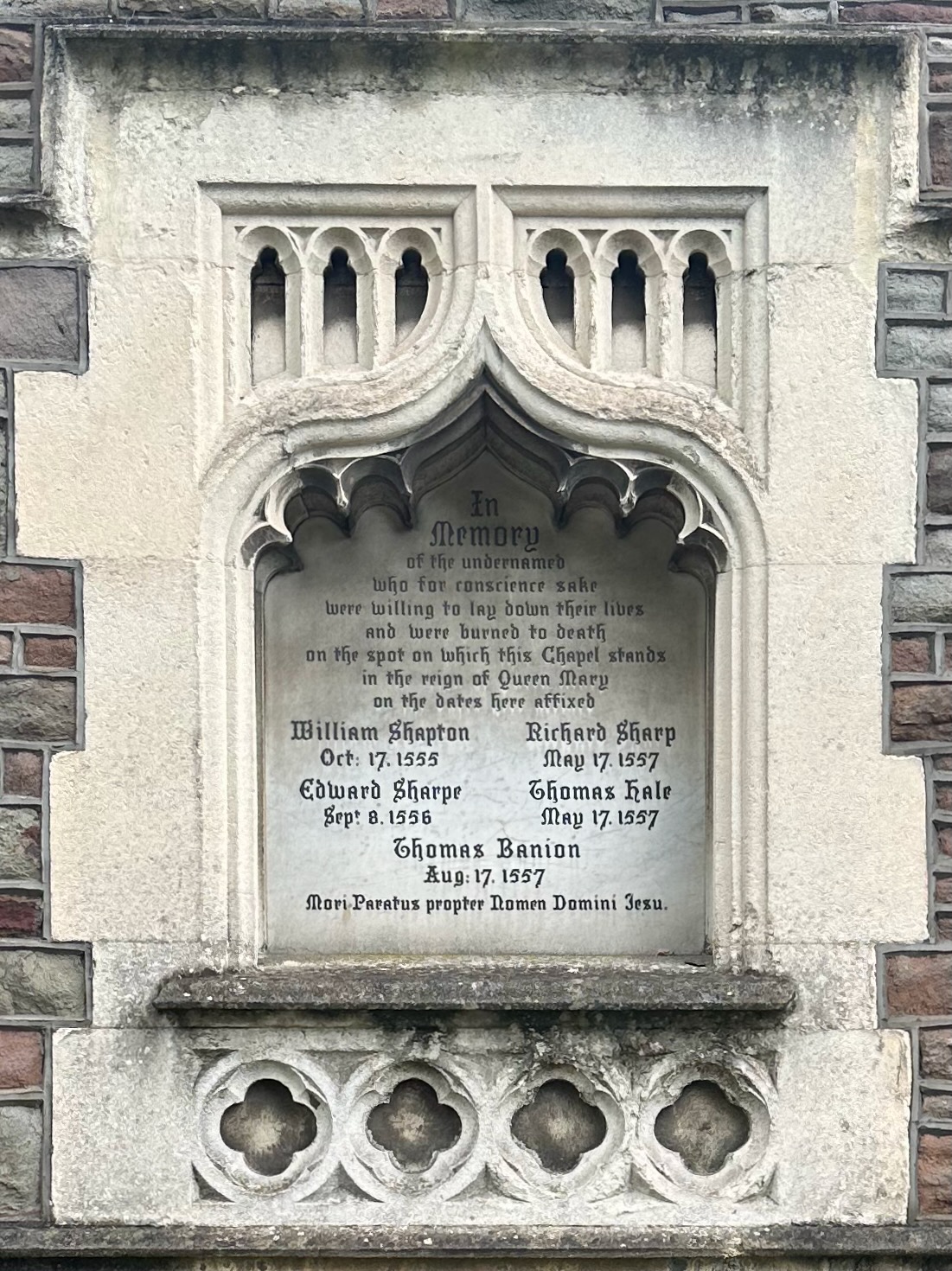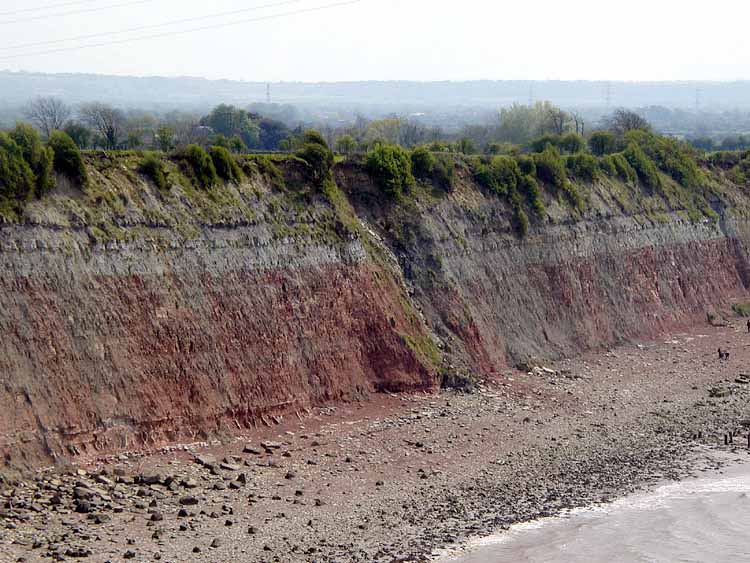|
Bewell's Cross
Bewell's Cross is a lost monument which marked the boundary of the county of Bristol when this was created in 1373. The name goes back at least as far as 1188, however, when it is referred to in a charter of King John 'quandam crucem vocatam Bewellescross' (a certain cross called Bewell's Cross). The 1373 survey mentions the Cross twice, noting that those perambulating the boundary should go up the highway to Henbury 'as far as a certain cross called Bewellescrosse, and from thence further northwards as far as a stone fixed hard by the spring of Bewelle.'. It then goes on to say that the boundary returned back south along 'the same king’s highway as far as another stone fixed hard by the aforesaid cross on the eastern part of the same cross'. The cross stood in or close to the Gallows Field at the top of St Michael's Hill, the former principal road from Bristol to Wales via the Severn ferry at Aust. This is where the Bristol's 'Marian Martyrs' were burnt in 1556-7, events descr ... [...More Info...] [...Related Items...] OR: [Wikipedia] [Google] [Baidu] |
County
A county is a geographic region of a country used for administrative or other purposesChambers Dictionary, L. Brookes (ed.), 2005, Chambers Harrap Publishers Ltd, Edinburgh in certain modern nations. The term is derived from the Old French denoting a jurisdiction under the sovereignty of a count (earl) or a viscount.The Oxford Dictionary of English Etymology, C. W. Onions (Ed.), 1966, Oxford University Press Literal equivalents in other languages, derived from the equivalent of "count", are now seldom used officially, including , , , , , , , and ''zhupa'' in Slavic languages; terms equivalent to commune/community are now often instead used. When the Normans conquered England, they brought the term with them. The Saxons had already established the districts that became the historic counties of England, calling them shires;Vision of Britai– Type details for ancient county. Retrieved 31 March 2012 many county names derive from the name of the county town (county seat) with t ... [...More Info...] [...Related Items...] OR: [Wikipedia] [Google] [Baidu] |
Bristol
Bristol () is a city, ceremonial county and unitary authority in England. Situated on the River Avon, it is bordered by the ceremonial counties of Gloucestershire to the north and Somerset to the south. Bristol is the most populous city in South West England. The wider Bristol Built-up Area is the eleventh most populous urban area in the United Kingdom. Iron Age hillforts and Roman villas were built near the confluence of the rivers Frome and Avon. Around the beginning of the 11th century, the settlement was known as (Old English: 'the place at the bridge'). Bristol received a royal charter in 1155 and was historically divided between Gloucestershire and Somerset until 1373 when it became a county corporate. From the 13th to the 18th century, Bristol was among the top three English cities, after London, in tax receipts. A major port, Bristol was a starting place for early voyages of exploration to the New World. On a ship out of Bristol in 1497, John Cabot, a Venetia ... [...More Info...] [...Related Items...] OR: [Wikipedia] [Google] [Baidu] |
Henbury
Henbury is a suburb of Bristol, England, approximately north west of the city centre. It was formerly a village in Gloucestershire and is now bordered by Westbury-on-Trym to the south; Brentry to the east and the Blaise Castle Estate, Blaise Hamlet and Lawrence Weston to the west. To the north lie the South Gloucestershire village of Hallen and the entertainment/retail park Cribbs Causeway. The Hazel Brook (also known as the Hen), a tributary of the River Trym, flows through Henbury and crosses Henbury Road in a small ford near The Henbury Arms carvery restaurant. The ford is more than a foot deep relatively often and a small bridge exists as a main route for motor vehicles a few metres away. Henbury is also the name of a council ward for Bristol City Council that includes both Henbury and Brentry. Henbury Golf Club sits on the south border. History Henbury was first mentioned in 692 as ''Heanburg''. The name is from the Old English ''hēan byrig'', meaning 'high fortifie ... [...More Info...] [...Related Items...] OR: [Wikipedia] [Google] [Baidu] |
Marian Martyrs Memorial Cotham Church
Marian may refer to: People * Mari people, a Finno-Ugric ethnic group in Russia * Marian (given name), a list of people with the given name * Marian (surname), a list of people so named Places *Marian, Iran (other) * Marian, Queensland, a town in Australia * Marian, a village in toe commune of Hîrtop, Transnistria, Moldova * Lake Marian, New Zealand * Marian Cove, King George Island, South Shetland Islands * Mt Marian, Tasmania, a mountain in Australia * Marian, Albania, a village near Lekas, Korçë County Christianity * Marian, an adjective for things relating to the Blessed Virgin Mary (Roman Catholic), specifically Marian devotions * Congregation of Marian Fathers, also known as Marians of the Immaculate Conception, a Roman Catholic male clerical congregation Schools * Marian Academy, a Roman Catholic private school in Georgetown, Guyana * Marian College (other) * Marian High School (other) * Marian University (Indiana) * Marian University (Wisco ... [...More Info...] [...Related Items...] OR: [Wikipedia] [Google] [Baidu] |
Wales
Wales ( cy, Cymru ) is a Countries of the United Kingdom, country that is part of the United Kingdom. It is bordered by England to the Wales–England border, east, the Irish Sea to the north and west, the Celtic Sea to the south west and the Bristol Channel to the south. It had a population in 2021 of 3,107,500 and has a total area of . Wales has over of coastline and is largely mountainous with its higher peaks in the north and central areas, including Snowdon (), its highest summit. The country lies within the Temperateness, north temperate zone and has a changeable, maritime climate. The capital and largest city is Cardiff. Welsh national identity emerged among the Celtic Britons after the Roman withdrawal from Britain in the 5th century, and Wales was formed as a Kingdom of Wales, kingdom under Gruffydd ap Llywelyn in 1055. Wales is regarded as one of the Celtic nations. The Conquest of Wales by Edward I, conquest of Wales by Edward I of England was completed by 1283, th ... [...More Info...] [...Related Items...] OR: [Wikipedia] [Google] [Baidu] |
Severn
, name_etymology = , image = SevernFromCastleCB.JPG , image_size = 288 , image_caption = The river seen from Shrewsbury Castle , map = RiverSevernMap.jpg , map_size = 288 , map_caption = Tributaries (light blue) and major settlements on and near the Severn (bold blue) , pushpin_map = , pushpin_map_size = 288 , pushpin_map_caption= , subdivision_type1 = Country , subdivision_name1 = England and Wales , subdivision_type2 = , subdivision_name2 = , subdivision_type3 = Region , subdivision_name3 = Mid Wales, West Midlands, South West , subdivision_type4 = Counties , subdivision_name4 = Powys, Shropshire, Worcestershire, Gloucestershire , subdivision_type5 = Cities , subdivision_name5 = Shrewsbury, Worcester, Gloucester, Bristol , length = , width_min = , width_avg = , width_max = , depth_min = , depth_avg = ... [...More Info...] [...Related Items...] OR: [Wikipedia] [Google] [Baidu] |
Aust
Aust is a small village in South Gloucestershire, England, about north of Bristol and about south west of Gloucester. It is located on the eastern side of the Severn estuary, close to the eastern end of the Severn Bridge which carries the M48 motorway. The village has a chapel, a church and a public house. There is a large area of farmland on the river bank, which is sometimes flooded due to the high tidal range of the Severn. Aust Cliff, above the Severn, is located about from the village. The civil parish of Aust includes the villages of Elberton and Littleton-upon-Severn. History Overview Aust, on the River Severn, was at one end of an ancient Roman road that let to Cirencester. Its name, Aust, may be one of the very few English place-names to be derived from the Latin ''Augusta''. The name of Aust is recorded in 793 or 794 as ''Austan'' (''terram aet Austan v manentes'') when it was returned to the Church of Worcester after having been taken by King Offa's earl, Bynna ... [...More Info...] [...Related Items...] OR: [Wikipedia] [Google] [Baidu] |
Cotham Church
Cotham Church is a Gothic Revival style church in Cotham, Bristol, England. Since 1975, it has been a Church of England parish church known as the Church of St Saviour with St Mary or simply as Cotham Parish Church. History Cotham Church was originally Highbury Congregational Chapel, built in 1842 and completed in 1843. The architect was William Butterfield and this was his first commission, obtained through his family's connection with William Day Wills of the tobacco firm W. D. & H. O. Wills. The exact site seems to have been chosen in part because its association with the 'Marian Martyrs' who were burned to death for heresy on the site during the 1550s. There is a memorial to them on the exterior north wall of the church. The church's apse, tower, south transept and school were added in 1863 by Edward William Godwin. The large stone low in the enclosing wall along Cotham Road is part of Bewell's Cross, which marked the boundary of the city until the nineteenth century. ... [...More Info...] [...Related Items...] OR: [Wikipedia] [Google] [Baidu] |
The Gallows, St Michaels Hill, Bristol (1743)
''The'' () is a grammatical article in English, denoting persons or things that are already or about to be mentioned, under discussion, implied or otherwise presumed familiar to listeners, readers, or speakers. It is the definite article in English. ''The'' is the most frequently used word in the English language; studies and analyses of texts have found it to account for seven percent of all printed English-language words. It is derived from gendered articles in Old English which combined in Middle English and now has a single form used with nouns of any gender. The word can be used with both singular and plural nouns, and with a noun that starts with any letter. This is different from many other languages, which have different forms of the definite article for different genders or numbers. Pronunciation In most dialects, "the" is pronounced as (with the voiced dental fricative followed by a schwa) when followed by a consonant sound, and as (homophone of the archaic pron ... [...More Info...] [...Related Items...] OR: [Wikipedia] [Google] [Baidu] |





.png)